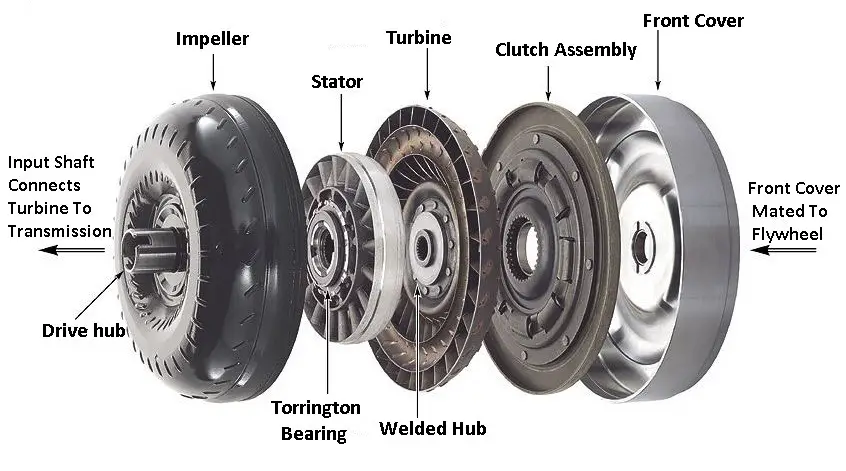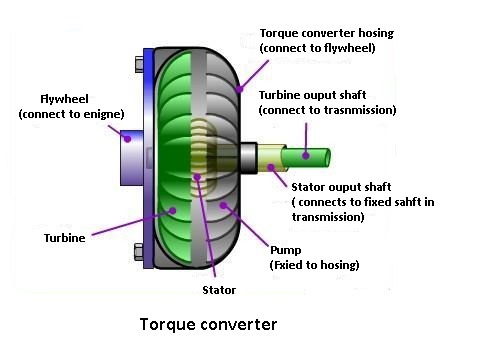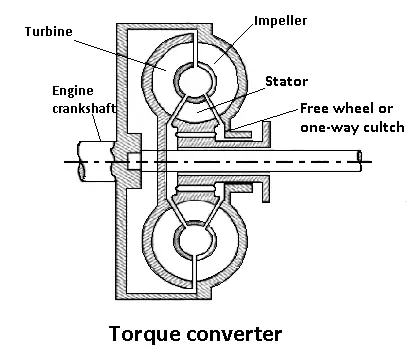In this article, you learn what is torque converter and how it work? with its advantages and applications of Torque Converter.
Download the PDF file at the bottom of this article.
What is a Torque Converter?
A torque converter is a device that performs a function similar to that of a gearbox, that is, to increase the torque while reducing the speed. The gearbox provides only a small number of fixed ratios, the torque converter provides a continuous variation of ratio from the lowest to the highest.
A torque converter is designed to obtain a mechanical advantage or gear ratio by hydraulic means in the same manner as gears do by mechanical means. It provides a maximum gear ratio starting from rest and gradually decreases that ratio as the vehicle gains speed.
Read Also: 9 Different Types of Differentials & How They Work?
Construction of Torque Converter
The construction of a torque converter is similar to that of fluid coupling, the only difference is that it has an additional stationary member called the reaction member.
Thus, a torque converter consists of three principal member, instead of two, these are:

- The driving member or impeller or pump, which is connected to the engine.
- The driving member or rotor or turbine, which is connected to the propeller shaft.
- Stationary member or reaction member or stator, which is fixed to the frame. It is a member which makes it possible to obtain a change of torque between input and output shafts. The fluid coupling does not have this member and cannot produce any change of torque.
- The stator is mounted on a freewheeling one-way clutch so that it can turn in only one direction. A stationary shaft, called the reaction shaft, extends from the geared transmission in the back of the converter through the pump to support the stator.
The driven member (turbine) faces the stator and is splined to the input shaft which rotates inside the reaction shaft and connects curved blades to project most of the oil into a hollow cylinder parallel to the axis of rotation.
The turbine is driven by the stream of oil sent to it by the pump. The oil enters the blade section near the rim and passes through the blades. The entire assembly is contained and linked to the engine flywheel.
Read also: What is a Manual Transmission? Advantages & Disadvantages
Parts of Torque Converter
The following are the main parts of a torque converter:
#1 Torque Converter Pump
The torque converter casing is connected to the flywheel by the pump. It causes the fluid inside the casing to circulate and move against the direction in which the casing is rotating.
#2 Turbine
The turbine powers the output shaft and is located closer to the pump and flywheel. Its rotation is counter to that of the fluid rotation, which efficiently absorbs torque and permits the output shaft to move.
#3 Stator
The stator is critical to ensuring that the fluid exits the turbine in the appropriate direction. Its job is to make sure the fluid moves in the same way as the pump.
The torque converter operates because of these three primary parts: the stator, turbine, and pump.
Working of Torque Converter
When the engine is running idle, the pump produces a slow of oil, as the engine drives it. This slow circulation of oil is not sufficient to move the turbine.
When the throttle is opened wide, the engine speed increases, and the pump moves faster projecting the oil toward the turbine. But the oil still has less force which is insufficient to turn the turbine. Therefore the oil returns to the pump. With almost no loss of velocity, except that due to friction.

The net effect of the redirection of flow is to increase pump output. The pump output under these conditions is the output velocity that it is creating because of the engine torque, plus the velocity of the redirected oil.
A built-up output velocity of two to three times the output velocity due to the engine alone is achieved when the turbine is stationary.
This makes the turning force of the turbine three times that of the engine. The increased torque of the turbine enables it to rotate and thus drives the input shaft, which in turn transmits the power to a geared section of the transmission.
Whereas the fluid coupling transmits the same torque as given to it by the engine, the torque converter
In a
Read also: What is Carburetor and Types of Carburetor [Complete Guide]
Torque Converter as a Fluid Coupling
The figure shows a simplified diagram of the
A torque converter is a type of fluid coupling that uses a fluid to transmit torque from one shaft to another. The Converter has a stator, However, at higher speeds, the torque converter works as a fluid coupling, giving the gear ratio 1:1.

When the vehicle speed increases from slow to high, the need for mechanical advantages decreases and the gear ratio of the torque converter gradually changes to that of a fluid coupling. It is so because the turbine speed gradually approaches the pump speed.
This reduces the vortex flow so that less oil is sent back to the pump by the turbine and stator. When the turbine speed reaches a point where the oil flow to the stator is no longer reflected, the stator starts to move with the rotating oil. This is the fluid coupling stage where the gear ratio becomes 1:1.
This action depends upon the throttle opening and vehicle load. At light throttle and steady load, the gear ratio may approach 1:1 at low speed. The torque converter automobile provides the effect of gear ratio as the need arises.
Such a condition as hill climbing or rapid acceleration produces the change. In descending steep grades, the torque converter is as effective as a fluid coupling in transmitting torque to produce engine braking.
Read Also: What are Engine Valves? Types & Working [Explained]
Types of Torque Converters
The following are different types of torque converters:
Single-stage Torque Converter
Some automatic transmissions feature single-stage torque converters. These are a more simple form of the conventional torque converter. They are lighter and more compact because they only have one set.
The single-stage torque converter consists turbine, the stator, and the impellers. It comes in two styles of housing: stationary and rotating.
Single-stage converters may be less efficient than multi-stage counterparts, although offering smoother power transfer and allowing the engine to idle without stalling.
Three-stage Torque Converter
These types of torque converters employ two sets of reactor or stator blades and three rings of turbine blades. This design considerably increases torque, allowing for up to five times the engine’s output torque, especially while the engine is stopped.
Three-stage converters are rated for several engine ranges, such as 335 horsepower at 2400 rpm, 420 horsepower at 2200 rpm, and 580 horsepower at 2200 rpm, depending on the exact design. A three-stage converter is offered in both fixed and rotating housings.
Advantages of Torque Converter
- It allows your vehicle to completely stop without stalling the engine.
- It makes driving easier.
- The torque converter gives more torque to your car when you accelerate out of the stop.
- The torque converter removes the clutch and produces the maximum torque compared to a vehicle equipped with a clutch.
- Modern torque converters increase the torque of the engine by two or three times.
Disadvantages of Torque Converter
- It has high efficiency within a narrow range of speeds.
- It also has high fuel consumption, which depends on the speed of engine rotation.
- These are quite expensive to maintain.
- They are likely to have a cavity, hence it is also a drawback.
- They require more fluid to be replaced from time to time.
Closing It Up
That’s it thanks for reading. So now, we hope that we have cleared all your doubts about the Torque Converter. If you still have any doubts about the “Torque Converter Working” you can contact us or ask in the comments. If you like our article, then please share it with your friends.
Subscribe to our newsletter to get notified when we upload new posts.
Download PDF of this article:
You may be interested in reading these articles:
- What Is Overdrive Transmission And How It Works?
- How does a leaf spring suspension work?
- What is Wankel Rotary Engine? Parts & Working [Explained]
FAQs
The torque converter is a fluid coupling that allows the engine to rotate independently of the transmission. It is responsible for pressurizing automatic transmission fluid, which provides the force required to shift gears in a transmission.
It produces less noise, reduces wear on transmission components, provides smooth clutch engagement, and does not require human intervention to work.
Inside the casing, fluid is driven by centrifugal force from the pump. After that, the fluid moves in the direction of the turbine, which is equipped with tiny grates that let the fluid in and drive the turbine. The turbine starts to rotate as it absorbs the torque.
In a manual transmission, the torque converter is the counterpart of the clutch. The transmission and engine are separated by it.
nice one thanks
Welcome.
That’s nice notes and it makes students to understand engineering
I’m glad it was helpful for you.